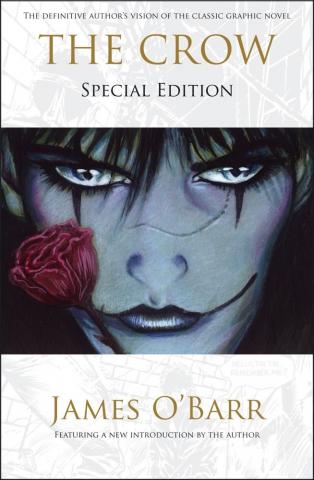The Transcendental Union: How The Crow Creates Connections Between the Writer and the World
May 10,2016
Ralph Waldo Emerson once wrote in his essay, The Poet, that nothing in books was of greater value to him, except for the transcendental and the extraordinary (12). Transcendentalism is an American literary and philosophical movement surrounding much of Emerson’s work as well as the works of Henry David Thoreau and Margaret Fuller during the early nineteenth century receiving much acclaim. It is a unifying force that views all living things as part of larger spirit encouraging poets to open up to the beauty of nature in order form intimate connections with aspects greater than themselves.
According to Richard Jackson in Radiant Lyre, poets enjoy a sensual existence fed by spiritual enrichment which is achieved by attaching themselves to their environment (84-85). These connections not only enable poets to establish an intimate relationship with nature, but also an intimate relationship with their audience. Emerson explained that there is a great power of public appeal through transcendentalism, but before poets can obtain it, they must first open up to the nature within themselves. Once they are able to do this their speech becomes powerful, their language erotic, and they become one with the universe (10).
It is through their use of erotic language that their audiences become engaged. Erotic language is portrayed both physical and spiritual. One of the physical associations Longenbach recommends using for poets to produce ‘good writing’ is the portrayal of the five senses which lures in readers (44). According to Emerson poets should be so much in touch with their environment or experience that they should be able to feel it (2). In addition poets that sensually engage with their environments record their experiences more faithfully and produce what become known as the ‘songs of nations’ (3).
Nowhere in poetry, have I found sensual language portrayed more deeply or darkly than in the work of James O’Barr. In his graphic novel The Crow, O’Barr transcends to his audience through his experience of losing a loved one. His story recounts the deaths of a young couple in Detroit who were brutally murdered by a band of organized and ruthless thugs. In order to seek justice in world where there was none, O’Barr designed his protagonist, Eric Draven, to serve as the avenger for these wrong doings. Through the guidance of a hypnotic crow that raised him from the dead, Draven seeks out and destroys the harbingers of his pain and misery. The Crow is more than just a poem written by a shattered soul; it is a journey that strives to create peace through vengeance. Transcendentally it is representative of the love of truth, the love of good, and the love of beauty (Emerson: 3).
O’Barr’s recognition of his experiences and engagement with his surroundings has resulted in the use of strong erotic language that captures his audience; rhapsodizing them in Draven’s emotional turmoil. It is through these connections that O’Barr bridges the gap between reality and the sole both thematically and poetically, enabling his audience to empathize with his perspectives who adopt his experiences as their own. According to Emerson if the imagination intoxicates the poet; it is not inactive in other men: ‘The metamorphosis excites in the beholder an emotional joy’ (11).
When poets connect to their environment and experiences they are forming connections within themselves. Through the acknowledgement of this intimacy, poets can expect to form bonds of intimacy with their audience. However, if poets separate themselves from their environment and experiences then there will be a lack of intimacy between the poet and the self which will produce bland diction and ultimately lead to a lack of intimacy between the poet and their audience.
Terry Tempest-William’s mentions in her memoir, Refuge, that “men’s subjection of women and the earth is due to a loss of intimacy within themselves” (10). I have found that when I write poetry, a loss of personal intimacy with what I am writing produces bland diction. Likewise, when I read poetry where the poet is disconnected from their experiences and environment, the bonds of intimacy and passion between us break before they can even be created. Longenbach explained that when descriptions are unmotivated they produce instant boredom in readers (42).
Symbollically, in The Crow, Eric Draven suffers a loss of intimacy with his lover, Shelly Webster. His intimacy is replaced by pain, sorrow, and hate which O’Barr expresses in the poem White Heat:
Here a shadow of a shadow,
an earth bound ghost shivers,
not from October chill,
but in erotic pain.
Here, the audience receives a taste of the imagery and the emotions O’Barr is expressing. According to Emerson all men live by truth and the need to express their painful secrets. He explains that ‘the man is only half himself and the other half of him is his expression’ (2). This poem offers insight into the painful truth of Draven’s regret. Emerson further explains: ‘over everything stands its daemon, or soul, and, as the form of the thing is reflected by the eye, the soul of the thing is reflected by a melody’ (9):
He says to his dead lover:
“We should never have come here
With flesh so soft and hearts so unwise,
But like tigers in tall, tall grass,
Like Christ in the garden of Gethsemane
We sucked in our fear
And we came here.”
Now all the atrocities are replayed
Like a late, late show
“We came here but we never should have stayed.
Though we have inertia, radius, and depth,
We took the last train with velocity,
And passed our own deaths.”
The greatest methods poets use in order to become intimate with themselves so that they can transcend to their audience are meditation and sublimity. During the Romantic Era, pastoral poetry focused on not only the natural setting, but also on the inner self: a self within nature (139). Emerson’s goal during this era was to recreate a connection between himself and the environment.
During the beginning of the industrial revolution nature was perceived as a refuge to retreat and rediscover the self (139). However, Pastoralism was not only associated with the environment of the natural world but was regarded as an experience due to its elaboration of ease, song, meditation, rest, mourning, and love (140).
The Crow, however, is set within an urban atmosphere. I believe that like nature, civilization is also an environment, and though unnatural, Draven engages with it and experience reality. Emerson stated: ‘A thought so passionate and alive, that, like the spirit of a plant or an animal, it has architecture of its own and adorns nature with a new thing’ (4). If nature is a symbol in the whole of every part as Emerson has stated, then isn’t civilization part of it, too?
Radiant Lyre explained Pastoralism encourages poets to meditate so they can live in the moment (143-144). Living in the moment allows poets to form a sense of intimacy with themselves so that they can think, feel, and express their experiences. In pastoral poetry the landscape is used as the object of meditation (145). However, in The Crow the city is used as the landscape for meditation.
Meditation is viewed as a method to detach oneself from the world. However, I believe that it can also be used in order to reconnect with one’s self so that we can return to the world. Though Draven disconnected from the world through his death, he returned to the world through the psychometric powers that the crow imparted to him. His newborn powers of psychometrics enabled him to reconnect with the realm of his life and past. Psychometrics is the psychic ability to interpret meaning through touch; an intimate candidate of the five senses. When one lives in the moment, their diction becomes enthralling and builds a union between the poet and their audience. Psychometry is symbolic for this.
Living in the moment, though, does not always mean to live in the present. Meditation can also be used as a bridge connecting different eras of the poet’s life. This process allows a poet to re-experience a moment or contemplate about the future by engaging with their inner world; particularly the realms of nostalgia and dreams. When a poet lives in the moment then that moment will be passed onto the reader to experience.
In O’Barr’s opening lament Pain and Fear he transcends to the audience through his recollection of a tragedy. His opening lament in The Crow recreates the scene of Eric and Shelly’s homicide and invites the audience to share in their experience:
A year ago… A cold October night…
A broken down car on a dirt road…
A man…A girl….Madness…Pain…And the shadows…
My god, the shadows….
He screams and screams and pounds his head
Against the wall until wailing phantom fire trucks
Pace across his vision.
Pain. Pain is all he wants.
And hate. Yes hate.
We shall never forget and never forgive.
And never ever fear.
Fear is for the enemy.
Fear and bullets.
Here, O’Barr uses meditation to connect with the environment and past experiences in order to portray them sensually and emotionally. In real life, O’Barr connects the sensuality and emotions portrayed in The Crow to the tragedy he suffered when his girlfriend was killed by a drunk driver. Through the setting of the lament his audience is given insight into the sensually feelings of sight, sound, and feel. From there the environment transgresses into an experience that portrays emotional terror.
Through O’Barr’s connection with his memory, he becomes intimate with himself and forms a connection between himself, his environment, and time. In addition, his connection with his experience enables him to reconnect with the sensual and emotional aspects that he endured during those moments resulting in the use of strong erotic language that forms a passionate union between poet and audience.
Like Pastoralism, the sublime also strives to connect people to the landscape and inspires emotion. It does not solely focus on beauty, but on environment and experience as well. While the meditative practice of pastoral poetry focuses more on the path of thought, the sublime focuses more on the portrayal of feelings. According to Radiant Lyre these feelings should be viewed as an experience of transcendence (169). The sublime experience is an emotional experience invoked by our surroundings (170).
Like meditation, it is the memories created by our sublime experiences that make them meaningful (185). The real intimacy of the sublime, though, is its ability to allow poets to reconnect with themselves (186-187). Compared to meditation, the sublime is more external than internal.
In The Crow, Shelly is symbolic of the sublime. Every moment Eric Draven spent with her was filled with intimate bliss. By reconnecting with his memories of Shelly he was reconnecting with his life; in other words himself. Even after death Eric Draven still refers to all things sublime in a feminine sense. Evidence for the sublime can be found in the poem Like a Concave Scream:
In the city,
where angels fear to hover,
and devils come to croon,
The sex of the night,
let’s down her black
narcotic hair
under a yellow opium moon.
Here, the environment and the city are expressed with the portrayal of feminine beauty. The portrayal of emotions is invoked by the poets’ external surroundings. There is also a great essence of intimacy in this poem that helps to enthrall O’Barr’s audience. According to Emerson, the poet is the transcendence of their own nature.
In the poem, White Heat, O’Barr portrays the city as a living breathing entity with a spirit of its own. His descriptions of the scenery bring the city to life in a world where love and happiness are dead and the only living things are dark and evil like the shadows. Emerson suggests that “expressing our sense that the evils of the world are such only to the evil eye” (7).
Still, so still in the city tonight,
Twelve o’clock,
Tick-tock,
When all that is good slinks
Away like a beaten dog and
The black black shadows are
Alive with the dead
Twisted poetry in broken English,
Flesh and blood and staring faces…
The dangers and fears of the urban setting are brought to life and they are used to express the emotions of pain, sorrow, and hate:
So Grey and despairing,
Strong as steal but collapsed inside,
The Crow laughs under a street light,
A voodoo smile of one who live
And died and yet still lives….
He makes his way home where
He can be shapeless in the dark
And paint his face in the colors of joy.
Tonight,
Hell sends and angel bearing gifts.
Here the external world of the poem collapses into Draven’s internal world. Again, O’Barr transcends to his audience by opening up to the experience. His transcendence paints a scenic picture in order to portray Draven’s pain. The depth of O’Barr’s language also creates an intimate bond between himself and his audience.
In conclusion, the unity of transcendentalism should not be stereotyped to the natural landscape. In fact, some of the most enthralling poetry I have ever read is associated with urban settings. Emerson wrote ‘we love the poet, the inventor, who in any form, has yielded us a new idea. He unlocks our chains and admits us to a new scene’ (12).
The city like the forest is an environment that we experience and are inspired by both physically and spiritually. It is the landscape used for O’Barr’s meditation where he can be one with time and emotion. Through our sensual portrayal of our experiences we transcend to the environment of our audience and our society.
By opening up to our environment and experiences poets will reconnect with themselves. Methods such as meditation and sublimity enable poets to connect or reconnect with their experiences so they can portray themselves sensually and emotionally. Through their connections with their environment and experiences poets produce good writing that readers don’t want to put down and will continuously return to in order to re-experience the moment. A poet’s audience is made up of people after all and part of connecting with the world involves connecting with other people. Through transcendentalism unity is obtained between poet and reader and the poet is made whole.
I believe the underlying goal of a poet is to be understood by their audience through their expression of themselves and this can be obtained through the virtues associated with Transcendentalism. If not to express ourselves, then why do we write poetry?
Bibliography
Emerson, R.W. “The Poet” Essays: Second Series (1844). Retrieved May 1, 2014 from: http://www.emersoncentral.com/poet.html
Jackson, R. Pankey, E. & Plumly, S. “Eros and the Erotics of Writing” “Meditative Spaces” & “The Intimate Sublime” “Radiant Lyre: essays on lyric poetry. Edited by David Baker and Ann Townsend. Graywolf Press, Saint Paul, MN (2007): 84, 139-145, 170-187
Longenbach, J. “Writing Badly” The Virtues of Poetry. Graywolf Press. Minneapolis, MN (2013): 43-48
O’Barr, J. “Pain and Fear” “White Heat” The Crow. Pocket Books, New York, NY (1995): 1, 15, & 51
Williams, T. “Burrowing Owls” Refuge. Second Vintage Books Edition (September, 2001). © Terry Tempest-Williams (1991, 2001): 10






